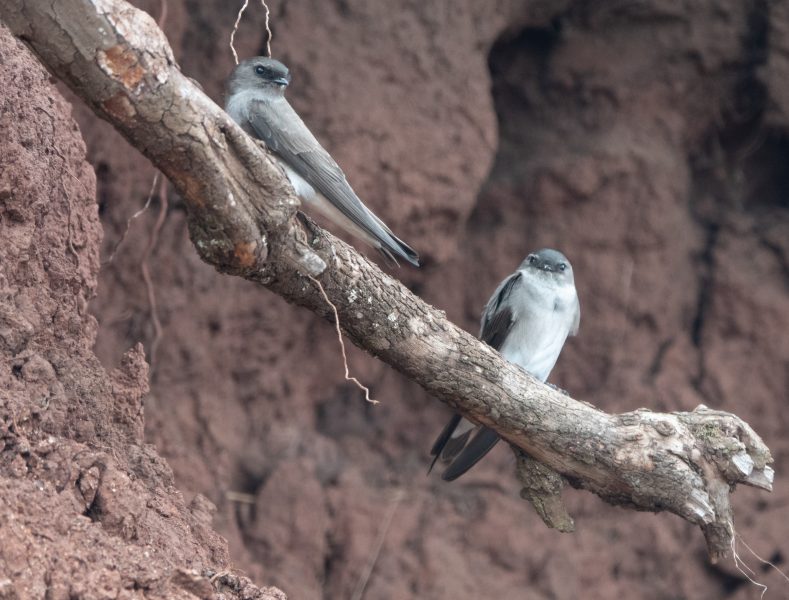Swallows and martins are admired for their graceful flight, their long migratory journeys and their often close association with humans, but they are probably not at the top of birders’ lists in Africa. In particular, the small and dull-coloured martins cannot compete with more “attractive” African bird species and may sometimes even pose identification challenges. Consequently, they are mostly only noticed when “nothing else” is to be seen. It is this lack of attention that could have prevented birdwatchers discovering that African martins possibly consist of more species than previously expected.

Figure 1: New martin Riparia sp., two individuals with somewhat variable coloration, Hululle, Arsi Mountains, Ethiopia, 3 June 2019. (Photo: K. Gedeon)
The quest for Ethiopian swallows and martins
On several journeys through Ethiopia in recent years, we spent some time studying not only endemic species such as the beautiful White-tailed Swallow Hirundo megaensis, but also other members of the family. This posed occasional identification difficulties, particularly among the greyish-brown species of rock martins Ptyonoprogne and martins Riparia. Their swift and acrobatic flight prevents any reliable estimation of body size, and otherwise diagnostic plumage contrasts are difficult to discern under poor light conditions. Our best bet was to observe the martins at rest, usually close to the breeding site. However, even then we were less than satisfied with our attempts to identify them, as some of the martins just looked different to the birds in the field guides. Nonetheless, these unidentifiable martins showed consistent plumage characters, and were often to be found associated with the widespread African Plain Martin R. paludicola, so we decided to look more closely at these gatherings of birds.

Figure 2: Different views of the new martin Riparia sp., Hululle, Arsi Mountains, Ethiopia, 3 June 2019. (Photo: K. Gedeon)
An exciting finding
Based on our collection of photos, videos and sound recordings, we found that the unusual martins did indeed differ in both appearance and vocalizations from the African Plain Martins. Although they may look generally alike, they are actually distinguishable from African Plain Martins by the all-white underparts running from the chin to the undertail-coverts, the greyer upperparts and a dark mask in front of the eyes. Moreover, they differ from the Ptyonoprogne species in their smaller size and lack of white tail spots. They also nest in burrows in earth banks, a behaviour more akin to the genus Riparia.

Figure 3: Habitat of the new martin Riparia sp. on the Afro-alpine plain of Guassa, Ethiopia (3,391 m), 18 October 2018; the breeding site is located on the road cutting to the left. (Photo: K. Gedeon)
So far, we have found these martins at eight different sites in Ethiopia, scattered across three regional states. All of these localities are within the known range of the African Plain Martin, and the suspect birds apparently sometimes occur in mixed breeding colonies. This, along with their pronounced vocal differences, suggests that we are actually dealing with two different species of martin.
An unnamed species?
So, why do we refrain from formally describing and naming them as a new species? First, we do not have a preserved bird that could be used as a type specimen. According to the internationally agreed code of the International Commission on Zoological Nomenclature, a new name should be established on the basis of at least one preserved type specimen. Since the Ethiopian Wildlife Conservation Authority (EWCA) has strong reservations about the collection of specimens and the related killing and keeping of individuals for further scientific studies, we could not get permission to collect a specimen or samples for molecular analyses. Second, we do not consider the description of a new taxon to be valid without molecular proof. Even so, we are currently working on a re-assessment of African martins that will include molecular genetics and hope to encourage the EWCA to reconsider their position and enable research based on international standards.
Author Information:
Zoologisches Forschungsmuseum Alexander Koenig, Sektion Ornithologie, Adenauerallee 160, 53113 Bonn, Germany. E-mail: k.gedeon@gmail.com; T.Toepfer@leibniz-zfmk.de
